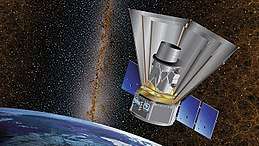SPHEREx
 Artist's concept of SPHEREx | |
| Mission type | Near-infrared telescope |
|---|---|
| Operator | NASA |
| Website |
spherex |
| Mission duration | 25 months (proposed) |
| Spacecraft properties | |
| Payload mass | 69 kg (152 lb)[1] |
| Start of mission | |
| Launch date | 2022 (proposed) |
| Main telescope | |
| Diameter | 20 cm[1] |
| Wavelengths | Near-infrared |
| Transponders | |
| Band | S band, Ka band[1] |
| Instruments | |
| spectrophotometer | |
SPHEREx (Spectro-Photometer for the History of the Universe, Epoch of Reionization, and Ices Explorer) is a proposed near-infrared space observatory that would perform an all-sky survey to measure the near-infrared spectra of approximately 450 million galaxies. SPHEREx is competing for selection by NASA for its next Medium-Class Explorers mission, which will take place in 2019. The other two competing mission concepts are Arcus, and FINESSE.[2] If selected and built, the launch date would be no earlier than 2022. The Principal Investigator is James Bock at Caltech in Pasadena, California.
Overview
SPHEREx would use a spectrophotometer to perform an all-sky survey that would measure near-infrared spectra from 0.75 to 5.0 micrometers. It employs a simple instrument with a single observing mode to map the entire sky four times during its nominal 25-month mission. [3] It would classify galaxies according to redshift accuracy, categorizing approximately 450 million galaxies and fitting measured spectra to a library of galaxy templates. Specifically, SPHEREx will probe signals from the intra-halo light and from the epoch of reionization.[3] It would explore what drove the early universe inflation, explore the origin and history of galaxies, and explore the origin of water in planetary systems.[3][4][1]
SPHEREx would complement planned Euclid and WFIRST spectroscopic surveys, but SPHEREx's lower redshift survey would allow its measurement of inflationary parameters to be mostly independent to provide a new line of evidence.[1][3]
The telescope lens will have a diameter of 20 centimeters with a wide 3.5° x 7° field of view, imaged onto four 2k x 2k mercury cadmium telluride (HgCdTe) photodetector arrays.[1]
History
SPHEREx proposal was submitted to NASA on 19 December 2014, and it was selected for further conceptual development (Phase A) on 30 July 2015 for the Small Explorer program (SMEX).[5][6] The detailed concept study report was submitted to NASA on 19 July 19 2016 but it was not selected for SMEX. An enhanced version of SPHEREx was submitted on 15 December 2016 as a Medium-Class Explorer (MIDEX), and it was selected as a finalist in August 2017, along two other competing missions: Arcus, and FINESSE.[2] Each team received $2 million to refine their mission concepts over nine-months.[2] Selection of the winner is expected to take place in 2019 and proceed with construction and launch. The earliest launch date would be in 2022. Medium-Class Explorer mission costs are capped at $250 million, not including the launch vehicle.[2]
References
- 1 2 3 4 5 6 Proposed Astrophysics Mission to Conduct the First Infrared Spectral Survey of the Entire Sky. 27 August 2017.
- 1 2 3 4 NASA Selects Proposals to Study Galaxies, Stars, Planets. Katherine Brown, NASA News. 9 August 2017.
- 1 2 3 4 SPHEREx Science. Caltech. 2018.
- ↑ Missions to probe exoplanets, galaxies, and cosmic inflation vie for $250 million NASA slot. Daniel Clery, Science Magazine, 16 August 2017.
- ↑ SPHEREx News. SPHEREx, Caltech.
- ↑ NASA Selects Proposals to Study Neutron Stars, Black Holes and More. Karen Northon, NASA News. 30 July 2015.
.png)